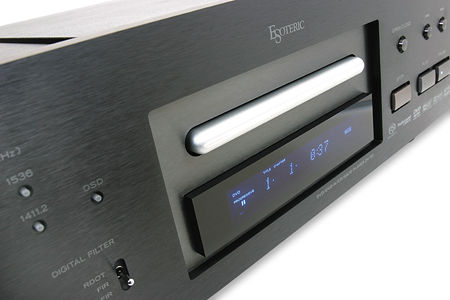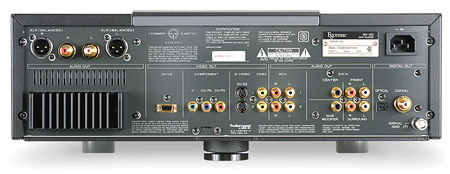Esoteric DV-50 universal disc player

But for as long as TEAC has made fine audio components, they have maintained a much lower profile than many other Japanese electronics companies. Perhaps this can be attributed to TEAC's longtime emphasis on their professional Tascam line of electronics. It's hard to visit a recording studio without seeing at least one piece of Tascam gear. TEAC has also concentrated on CD, CDR, and DVD drives for computers. Like their tape recorders, TEAC's computer drives have earned a reputation for reliability.
But what about ultra-high-end consumer electronics? Since the mid-1980s, TEAC has occasionally produced exquisitely crafted, very pricey components for their limited-edition Esoteric line. The latest Esoteric universal disc player, the DV-50, continues the TEAC tradition of making gear that not only weighs a lot, but also promises to deliver the ultimate in performance and durability. With a list price of $5500, the DV-50 had better be something special.
Just How Esoteric Is Esoteric?
The TEAC Esoteric DV-50 features a dazzling combination of leading-edge technology, first-class components, elegant styling, and high-end construction. The DV-50's chassis has a 5mm-thick bottom plate and a 6mm-thick top plate, both made of steel. The 47-pound player is supported on hardened-steel pinpoint feet coupled with integral receptacles designed to achieve optimal mechanical grounding. The front panel, made of thick, precision-machined aluminum, shows off TEAC's newly developed black finish.
Inside the DV-50 is enough cutting-edge technology to make an engineer's propeller beanie hover several feet above his head. CDs and DVDs both benefit from two exclusive circuits. TEAC's Refined Digital Output Technology (RDOT) upsamples the source signal's digital data four to 16 times the original rate: CDs wind up at 705.6kHz, DVDs at 768kHz. A specially configured Finite Impulse Response (FIR) filter increases the sampling rate by an additional 8x. With the RDOT circuit, a CD's sampling rate achieves a mind-numbing 1411.2kHz, while DVDs clock in at 1536kHz. In addition to upsampling digital sources with the RDOT and FIR circuits, the DV-50 also reclocks all digital signals using a master clock signal generated by a voltage-controlled crystal oscillator (VCXO). The DV-50 treats PCM and DVD digital signals very, very well.
The DV-50's disc transport features an 8mm-thick, large-diameter disc stabilizer. Two oversized locking brackets hold the entire mechanism, providing a rigid, extremely stable platform with which to rotate discs at high speeds. According to TEAC, this mechanism "greatly influences the precise reading of data, and thus has a dramatic effect on the overall sound and picture quality."
Unlike some universal players, which convert SACD DSD signals to PCM to perform digital signal processing, the DV-50 preserves SACD signals in their native form up to the final digital-to-analog conversion. High-slew-rate op-amps from National Semiconductor perform all current/voltage conversion for the D/A. Instead of a digital switching power supply, the DV-50 uses a cut-core transformer, along with Schottky barrier diodes on the power-circuit rectifiers. This reduces the switching and component noise that can adversely affect the audio output.

On the video side, the DV-50 uses the Analog Devices ADV7300A 108MHz, 12-bit video D/A converter, together with TEAC's super sub-alias filter, to achieve a claimed 540 lines of horizontal resolution. The DV-50's video amplifiers are special high-speed designs coupled with a lowpass filter designed for optimal group-delay characteristics.
Instead of using ordinary printed circuit boards, the DV-50 has four-layer plates of epoxy. Two layers carry signals, while the other two are for power and ground circuits. This method ensures that the power-supply, video, and audio signals remain separate. Besides the usual large-value chemical capacitors, the DV-50 has high-speed OS-CON and POSCAP caps, whose rapid discharge characteristics are said to far exceed those of standard tantalum caps. This medley of capacitors lets the DV-50 better cope with the rigorous demands of state-of-the-art audio and video reproduction.
Arcane Setup
Compared with universal players such as the Lexicon RT-10, the DV-50's setup menus at first seem Spartan. The most accessible video adjustments include those for aspect ratio and choice of progressive or interlaced outputs. The advanced settings include Progressive Motion adjustment, Brightness Noise Reduction (YNR), Color Noise Reduction (CNR), Mosquito Noise Reduction (MNR), Block Noise Reduction (BNR), high- and mid-frequency sharpness, white level, detail, black level, gamma, chroma level, and chroma delay. Memories can be set only from the Video Adjust sub-submenu, which is buried pretty deep in the menu structure.
The DV-50's Setup menu is divided into five submenus: two for audio, two for video, and one for general settings. The automatic Setup Navigator walks the user through the most important setup choices. However, speaker size (Large or Small), crossover options (80Hz or Full), and analog output levels for each speaker must be accessed manually through the Setup menu. Some options, such as the advanced video settings, can be accessed only via the General Setup submenu's Expert mode. Unlike the Lexicon RT-10, which offers the advanced user on-the-fly adjustments, the DV-50 protects its video settings from all but the most dedicated users.
On the audio side, for DVD-Audio and SACD (plus Dolby Digital and DTS—should you decide to use the onboard decoders for those formats) you can specify Large or Small speakers and vary the outputs from –6dB to +6dB. You can also set each individual speaker distances from one foot to over 36 feet, which automatically sets the proper delays for the primary listening position. For most users, the DV-50's speaker-adjustment choices will be more than adequate. The only missing feature is the ability to change the crossover points. For both of my systems, I chose the full-range speaker settings, because my Dunlavy and Genesis speakers can easily handle low frequencies.
The DV-50 provides a number of output options. For 2-channel analog audio, it offers one pair of balanced XLR and three pairs of single-ended RCA outputs. According to the instruction manual, the balanced XLR and one pair of single-ended RCA outputs (located between the XLR jacks) offer "superior quality" over the other two pairs of single-ended RCA jacks (located next to the 5.1 single-ended outputs). Six single-ended RCA jacks handle the dedicated 5.1-channel output. One coaxial and one TosLink comprise the digital outputs.
For video, the DV-50 offers two composite, two S-video, one component, and something called D1/D2. This last output is not the same as DVI; rather, it's a D-Video format that is used primarily in Japan. For the audio portion of this review, I primarily used both digital outputs and the analog 5.1 outputs. For video, I used the component outputs for both interlaced and progressive signals.













































